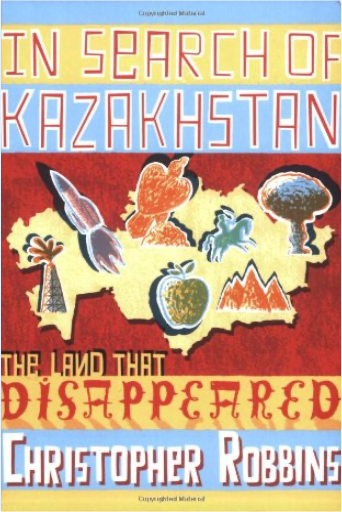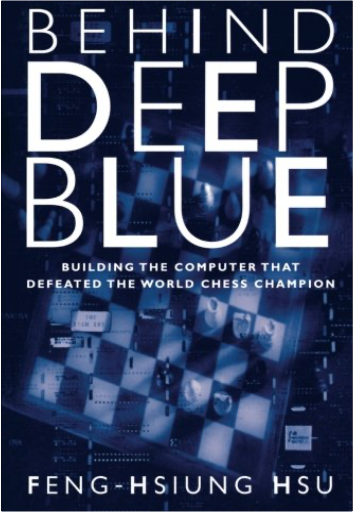 Behind Deep Blue: Building the Computer that Defeated the World Chess ChampionFeng-Hsiung Hsu Behind Deep Blue: Building the Computer that Defeated the World Chess ChampionFeng-Hsiung Hsu On May 11, 1997, as millions worldwide watched a stunning victory unfold on television, a machine shocked the chess world by defeating the defending world champion, Garry Kasparov. Written by the man who started the adventure, Behind Deep Blue reveals the inside story of what happened behind the scenes at the two historic Deep Blue vs. Kasparov matches. This is also the story behind the quest to create the mother of all chess machines. The book unveils how a modest student project eventually produced a multimillion dollar supercomputer, from the development of the scientific ideas through technical setbacks, rivalry in the race to develop the ultimate chess machine, and wild controversies to the final triumph over the world's greatest human player.
In nontechnical, conversational prose, Feng-hsiung Hsu, the system architect of Deep Blue, tells us how he and a small team of fellow researchers forged ahead at IBM with a project they'd begun as students at Carnegie Mellon in the mid-1980s: the search for one of the oldest holy grails in artificial intelligence—a machine that could beat any human chess player in a bona fide match. Back in 1949 science had conceived the foundations of modern chess computers but not until almost fifty years later—until Deep Blue—would the quest be realized.
Hsu refutes Kasparov's controversial claim that only human intervention could have allowed Deep Blue to make its decisive, "uncomputerlike" moves. In riveting detail he describes the heightening tension in this war of brains and nerves, the "smoldering fire" in Kasparov's eyes. Behind Deep Blue is not just another tale of man versus machine. This fascinating book tells us how man as genius was given an ultimate, unforgettable run for his mind, no, not by the genius of a computer, but of man as toolmaker. 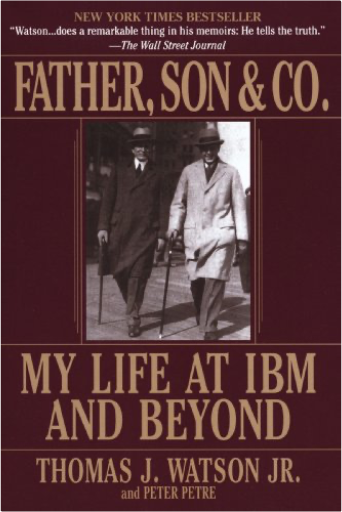 Father, Son & Co.: My Life at IBM and BeyondThomas J. Watson, Peter Petre Father, Son & Co.: My Life at IBM and BeyondThomas J. Watson, Peter Petre In this eloquent first-person account of a family drama that changed the face of American business, the man who transformed IBM into the world's largest computer company reflects on his lifelong partnership with his father—and how their management style and shared dedication to excellence united to create a unique corporate culture that became the blueprint for the entire technology boom.
In the course of sixty years Thomas J. Watson Sr. and his son, Thomas J. Watson Jr., together built the international colossus that is IBM. This is their story: a riveting and revealing account of two men who loved each other—and fought each other—with a terrible fierceness.
But along with the story of a father and son, this is IBM's story too. It chronicles the management insights that shaped its course and its unique corporate culture, the style that made Thomas Watson Sr. one of America's most charismatic bosses, and the daring decisions by Thomas Watson Jr. that transformed IBM into the world's largest computing company. One of the greatest business-success stories of all time, Father, Son & Co. is a moving lesson for fathers who dream for their children, as well as a testament to American ingenuity and values, told in a disarmingly frank and eloquent voice.
Promising to remain an important business reference as we move into the next century, FATHER, SON & CO. takes a look at the management insight that helped to shape IBM's course and unique corporate culture. It looks at Watson, Sr., one of America's most charismatic bosses, and Watson, Jr., who spurred IBM into the computer age.
Ten years after its original publication, FATHER, SON & CO. remains a uniquely honest book. Watson's willingness to write about the loving but ferociously combative relationship he had with his father and the turbulent battles behind some of IBM's most far-reaching decisions gives readers rare insights into the realities of leadership. —> 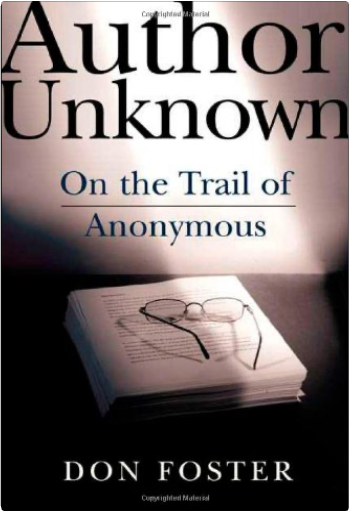 Author Unknown: On the Trail of AnonymousDon Foster Author Unknown: On the Trail of AnonymousDon Foster From the professor who invented literary forensics—and fingered Joe Klein as the author of Primary Colors—comes the inside story of how he solves his most challenging cases
Don Foster is the world's first literary detective. Realizing that everyone's use of language is as distinctive as his or her DNA, Foster developed a revolutionary methodology for identifying the writer behind almost any anonymous document. Now, in this enthralling book, he explains his techniques and invites readers to sit by his side as he searches a mysterious text for the clues that whisper the author's name.
Foster's unique skills first came to light when a front-page New York Times article announced his discovery that a previously unattributed poem was written by Shakespeare. A few weeks later, Foster solved the mystery that had obsessed America for months when he identified Joe Klein as the author of Primary Colors. Foster also took on a case involving the elusive Thomas Pynchon. And his contributions to the Unabomber and JonBenet Ramsey cases have led the FBI and several police forces to hire him to train their organizations.
Introducing a fascinating new field of forensics, Author Unknown will appeal to mystery fans-and to everyone interested in words and the writer's craft.  A Mathematician Reads The NewspaperJohn Allen Paulos A Mathematician Reads The NewspaperJohn Allen Paulos John Allen Paulos is a master at shedding mathematical lights on our everyday world:What exactly did Lani Guinier say about quotas?What is the probability of identifying a murderer through DNA testing?Which are the real risks to our health and which the phony ones?Employing the same fun-filled, user-friendly, and quirkily insightful approach that put Innumeracy on best-seller lists, Paulos now leads us through the pages of the daily newspaper, revealing the hidden mathematical angles of countless articles. From the Senate, the SATs, and sex to crime, celebrities, and cults, Paulos takes stories that may not seem to involve mathematics at all and demonstrates how mathematical naïveté can put readers at a distinct disadvantage.Whether he's using chaos theory to puncture economic and environmental predictions, applying logic and self-reference to clarify the hazards of spin doctoring and news compression, or employing arithmetic and common sense to give us a novel perspective on greed and relationships, Paulos never fails to entertain and enlighten.Even if you hated math in school, you'll love the numerical vignettes in this book.  Museum Memories: History, Technology, ArtDidier Maleuvre Museum Memories: History, Technology, ArtDidier Maleuvre From its inception in the early nineteenth century, the museum has been more than a mere historical object; it has manufactured an image of history. In collecting past artifacts, the museum gives shape and presence to history, defining the space of a ritual encounter with the past. The museum believes in history, yet it behaves as though history could be summarized and completed. By building a monument to the end of history and lifting art out of the turmoil of historical survival, the museum is said to dehistoricize the artwork. It replaces historicity with historiography, and living history turns into timelessness. This twofold process explains the paradoxical character of museums. They have been accused of being both too heavy with historical dust and too historically spotless, excessively historicizing artworks while cutting them off from the historical life in which artworks are born. Thus the museum seems contradictory because it lectures about the historical nature of its objects while denying the same objects the living historical connection about which it purports to educate. The contradictory character of museums leads the author to a philosophical reflection on history, one that reconsiders the concept of culture and the historical value of art in light of the philosophers, artists, and writers who are captivated by the museum. Together, their voices prompt a reevaluation of the concepts of historical consciousness, artistic identity, and the culture of objects in the modern period. The author shows how museum culture offers a unique vantage point on the nineteenth and twentieth centuries’ preoccupation with history and subjectivity, and he demonstrates how the constitution of the aesthetic provides insight into the realms of technology, industrial culture, architecture, and ethics. 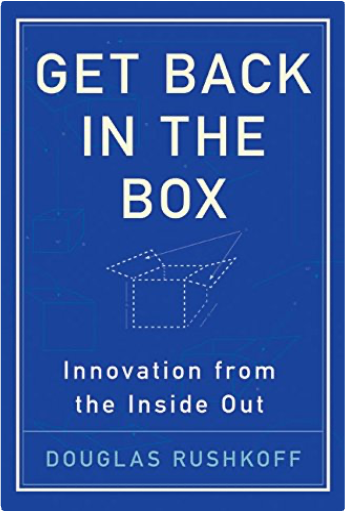 Get Back in the Box: Innovation from the Inside OutDouglas Rushkoff Get Back in the Box: Innovation from the Inside OutDouglas Rushkoff On a landscape that seems to be transforming itself with every new technology, marketing tactic, or investment strategy, businesses rush to embrace change by trading in their competencies or shifting their focus altogether. All in the name of innovation.
But this endless worrying, wriggling, and trend watching only alienates companies from whatever it is they really do best. In the midst of the headlong rush to think "outside the box," the full engagement responsible for true innovation is lost. New consultants, new packaging, new marketing schemes, or even new CEOs are no substitute for the evolution of our own expertise as individuals and as businesses.
Indeed, for all their talk about innovation, most companies today are still scared to death of it.
To Douglas Rushkoff, this disconnect is not only predictable but welcome. It marks the happy end of a business cycle that began as long ago as the Renaissance, and ended with the renaissance in creativity and collaboration we're going through today.
The age of mass production, mass media, and mass marketing may be over, but so, too, is the alienation it engendered between producers and consumers, managers and employees, executives and shareholders, and, worst of all, businesses and their own core values and competencies.
American enterprise, in particular, is at a crossroads. Having for too long replaced innovation with acquisitions, tactics, efficiencies, and ad campaigns, many businesses have dangerously lost touch with the process — and fun — of discovery.
"American companies are obsessed with window dressing," Rushkoff writes, "because they're reluctant, no, afraid to look at whatever it is they really do and evaluate it from the inside out. When things are down, CEOs look to consultants and marketers to rethink, rebrand, or repackage whatever it is they are selling, when they should be getting back on the factory floor, into the stores, or out to the research labs where their product is actually made, sold, or conceived."
Rushkoff backs up his arguments with a myriad of intriguing historical examples as well as familiar gut checks — from the dumbwaiter and open source to Volkswagen and The Gap — in this accessible, thought-provoking, and immediately applicable set of insights. Here's all the help innovators of this era need to reconnect with their own core competencies as well as the passion fueling them. 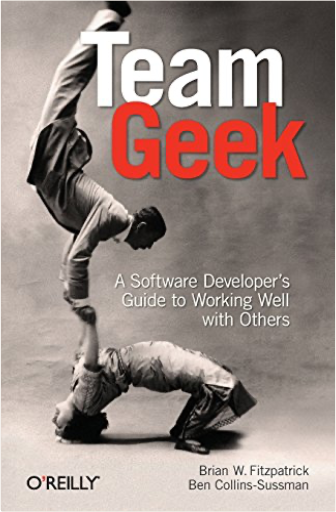 Team Geek: A Software Developer's Guide to Working Well with OthersBrian W. Fitzpatrick, Ben Collins-Sussman Team Geek: A Software Developer's Guide to Working Well with OthersBrian W. Fitzpatrick, Ben Collins-Sussman In a perfect world, software engineers who produce the best code are the most successful. But in our perfectly messy world, success also depends on how you work with people to get your job done.
In this highly entertaining book, Brian Fitzpatrick and Ben Collins-Sussman cover basic patterns and anti-patterns for working with other people, teams, and users while trying to develop software. This is valuable information from two respected software engineers whose popular series of talks—including "Working with Poisonous People"—has attracted hundreds of thousands of followers.
Writing software is a team sport, and human factors have as much influence on the outcome as technical factors. Even if you’ve spent decades learning the technical side of programming, this book teaches you about the often-overlooked human component. By learning to collaborate and investing in the "soft skills" of software engineering, you can have a much greater impact for the same amount of effort.
Team Geek was named as a Finalist in the 2013 Jolt Awards from Dr. Dobb's Journal. The publication's panel of judges chose five notable books, published during a 12-month period ending June 30, that every serious programmer should read. 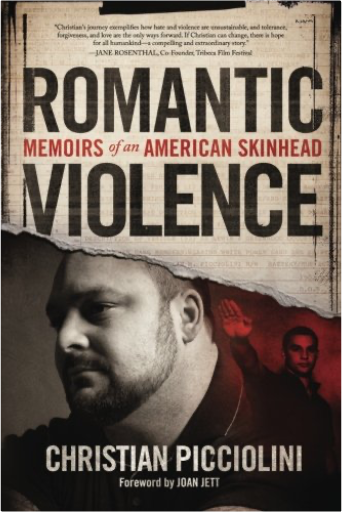 Romantic Violence: Memoirs of an American SkinheadChristian Picciolini Romantic Violence: Memoirs of an American SkinheadChristian Picciolini At 14 years old, Christian Picciolini, a bright and well-loved child from a good family, had been targeted and trained to spread a violent racist agenda, quickly ascending to a highly visible leadership position in America's first neo-Nazi skinhead gang. Just how did this young boy from the suburbs of Chicago, who had so much going for him, become so lost in extremist ideologies that would horrify any decent person? Romantic Violence: Memoirs of an American Skinhead is a poignant and gripping cautionary tale that details Christian's indoctrination when he was barely a teen, a lonely outsider who, more than anything, just wanted to belong. A fateful meeting with a charismatic man who recognized and took advantage of Christian's deep need for connection sent the next decade of his life into a dangerous spiral. When his mentor went to prison for a vicious hate crime, Christian stepped forward, and at 18, he was overseeing the most brutal extremist skinhead cells across the country. From fierce street brawls to drunken white power rallies, recruitment by foreign terrorist dictators to riotous white power rock music, Picciolini immersed himself in racist skinhead culture, hateful propaganda, and violence. Ultimately Christian began to see that his hate-filled life was built on lies. After years of battling the monster he created, he was able to reinvent himself. Picciolini went on to become an advocate for peace, inclusion, and racial diversity, co-founding the nonprofit Life After Hate, which helps people disengage from hate groups and to love themselves and accept others, regardless of skin color, religious belief, or sexual preference. 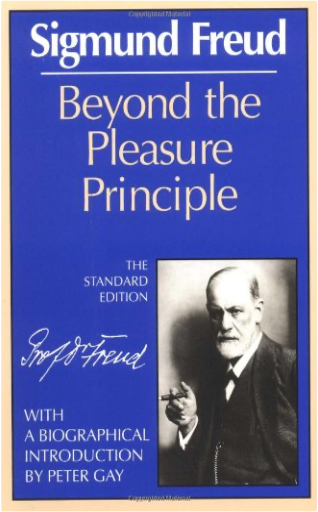 Beyond the Pleasure PrincipleSigmund Freud, James Strachey Beyond the Pleasure PrincipleSigmund Freud, James Strachey In 1915 at the University of Vienna 60-year-old Sigmund Freud delivered these lectures on psychoanalysis, pointing to the interplay of unconscious and conscious forces within individual psyches.In reasoned progression he outlined core psychoanalytic concepts, such as repression, free association and libido. Of the various English translations of Freud's major works to appear in his lifetime, only one was authorized by Freud himself: The Standard Edition of the Complete Psychological Works of Sigmund Freud under the general editorship of James Strachey.
Freud approved the overall editorial plan, specific renderings of key words and phrases, and the addition of valuable notes, from bibliographical and explanatory. Many of the translations were done by Strachey himself; the rest were prepared under his supervision. The result was to place the Standard Edition in a position of unquestioned supremacy over all other existing versions.Newly designed in a uniform format, each new paperback in the Standard Edition opens with a biographical essay on Freud's life and work ―along with a note on the individual volume―by Peter Gay, Sterling Professor of History at Yale.  The EssaysFrancis Bacon, John Pitcher The EssaysFrancis Bacon, John Pitcher The genius of Francis Bacon is nowhere better revealed than in his essays.
Bacon’s education was grounded in the classical texts of ancient Greece and Rome, but he brought vividness and color to the arid scholasticism of medieval book-learning. Whatever their subject, whether it is something as personal as “Friendship” or as abstract as “Truth,” the essays combine a mixture of rhetoric and philosophy; and are perhaps the most complete and rounded examples of Bacon’s literary style.
Rather than merely summarizing popular philosophy or producing glib expositions of correct conduct, Bacon attempted to change the shape of the other men’s minds. He believed rhetoric, as the force eloquence and persuasion, could incline the mind towards the pure light of reason. |
 Behind Deep Blue: Building the Computer that Defeated the World Chess ChampionFeng-Hsiung Hsu
Behind Deep Blue: Building the Computer that Defeated the World Chess ChampionFeng-Hsiung Hsu  Father, Son & Co.: My Life at IBM and BeyondThomas J. Watson, Peter Petre
Father, Son & Co.: My Life at IBM and BeyondThomas J. Watson, Peter Petre  Author Unknown: On the Trail of AnonymousDon Foster
Author Unknown: On the Trail of AnonymousDon Foster  A Mathematician Reads The NewspaperJohn Allen Paulos
A Mathematician Reads The NewspaperJohn Allen Paulos  Museum Memories: History, Technology, ArtDidier Maleuvre
Museum Memories: History, Technology, ArtDidier Maleuvre  Get Back in the Box: Innovation from the Inside OutDouglas Rushkoff
Get Back in the Box: Innovation from the Inside OutDouglas Rushkoff  Team Geek: A Software Developer's Guide to Working Well with OthersBrian W. Fitzpatrick, Ben Collins-Sussman
Team Geek: A Software Developer's Guide to Working Well with OthersBrian W. Fitzpatrick, Ben Collins-Sussman  Romantic Violence: Memoirs of an American SkinheadChristian Picciolini
Romantic Violence: Memoirs of an American SkinheadChristian Picciolini  Beyond the Pleasure PrincipleSigmund Freud, James Strachey
Beyond the Pleasure PrincipleSigmund Freud, James Strachey  The EssaysFrancis Bacon, John Pitcher
The EssaysFrancis Bacon, John Pitcher  Made with Delicious Library
Made with Delicious Library
